Table 5.2
A company makes four products that have the following characteristics: Product A sells for $75 but needs $20 of materials and $20 of labor to produce; Product B sells for $90 but needs $45 of materials and $20 of labor to produce; Product C sells for $110 but needs $50 of materials and $30 of labor to produce; Product D sells for $135 but needs $75 of materials and $40 of labor to produce. The processing requirements for each product on each of the four machines are shown in the table.

Work centers W, X, Y, and Z are available for 40 hours per week and have no setup time when switching between products. Market demand is 50 As, 60 Bs, 70 Cs, and 80 Ds per week. In the questions that follow, the traditional method refers to maximizing the contribution margin per unit for each product, and the bottleneck method refers to maximizing the contribution margin per minute at the bottleneck for each product.
-Use the information in Table 5.2. Which work center is the bottleneck operation?
Definitions:
Annual Taxes
Taxes that are assessed and paid once a year, commonly relating to income, property, or business revenues.
Net Working Capital
The difference between a company's current assets and current liabilities, indicating the liquidity and operational efficiency of the business.
Debt To Suppliers
The total amount of money a company owes to its suppliers for goods and services purchased on credit.
Floor Inventory
Inventory on hand that is available for sale to customers in a retail, wholesale, or manufacturing space.
Q40: A(n) _ line is a product line
Q43: Customers demand muffalettas at the rate of
Q80: Use the information provided in Table 8.4.
Q82: _ is a systematic approach to determine
Q95: Professor Willis noted that the popularity of
Q100: In the Toyota Production System, services and
Q101: Use the information in Figure 5.4. If
Q122: With the multiplicative seasonal method of forecasting:<br>A)
Q131: Use the data in Scenario 2.5 to
Q235: An industrial engineer observes a brand new